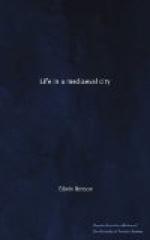A list of trades in the city will suggest the kinds of business there were. Some of the names will go far to explain some modern surnames.
Wool Trades:—
Mercers.
Tapiters and couchers (makers of tapestry,
hangings, carpets, and
coverlets).
Fullers.
Cardmakers.
Littesters (dyers, listers).
Shermen (shearmen).
Sledmen.
Dyers.
Weavers of woollen.
Leather Trades:—
Barkers (tanners).
Curriers.
Building Trades:—
Carpenters, wrights and joiners.
Plasterers.
Tilers.
Ironmongers.
Painters.
Glaziers.
Food Trades:—
Spicers (grocers—Cf.
French epicier).
Cooks and waterleaders.
Baxters (bakers).
Vintners and taverners.
Bouchers (butchers).
Pulters (poultry-dealers).
Wine-drawers (carters of wine).
Sauce-makers.[4]
Outfitting Trades:—
Tailors.
Skinners (vestment makers).
Glovers.
Hosiers.
Hatmakers.
Capmakers.
Cordwainers (cobblers).
Saddlers.
Girdlers and nailers.
Spuriers and lorimers (makers of spurs,
bits for bridles, etc.).
Armour Trades:—
Armourers.
Smiths.
Bowers and flecchers (fletchers)—(makers
of bows and arrows. Cf.
French fleche).
Household Trades:—
Coopers.
Pewterers and founders.
Chaundlers (makers of candles and wax
images).
Potters.
Culters.
Bucklemakers, sheathers, bladesmiths.
Drapers.
Linenweavers.
Miscellaneous Trades:—
Goldsmiths.
Latoners (workers in the metal called
latten).
Barber-surgeons (the mediaeval medical
practitioners).
Parchemeners and bookbinders.
Scriveners.
Writers of texts.
Ostlers (inn-holders).
Shipwrights.
Fishers and mariners.
Artist craftsmen of York supplied most of the churches of the north of England with their beautiful vessels, furniture, and ornaments. In the workshops of the city, the metropolis of the north, there were worked and made embroidered vestments of all kinds, engraved chalices and vessels of silver and of gold, and carved work, including statues and images in stone, wood, and wax. Bells were cast with beautiful lettering. Brasses for grave-slabs were made bearing finely designed effigies.
Marketing, i.e. trading, was done mostly at the frequent and regular markets and at the fairs. The right to hold a market or a fair was among the rights obtained by means of royal charters. While markets were held once or several times a week or every day, fairs took place more rarely and at some of the most important and popular holiday seasons of the year, like Whitsuntide. Fairs attracted a much larger public than the markets.




